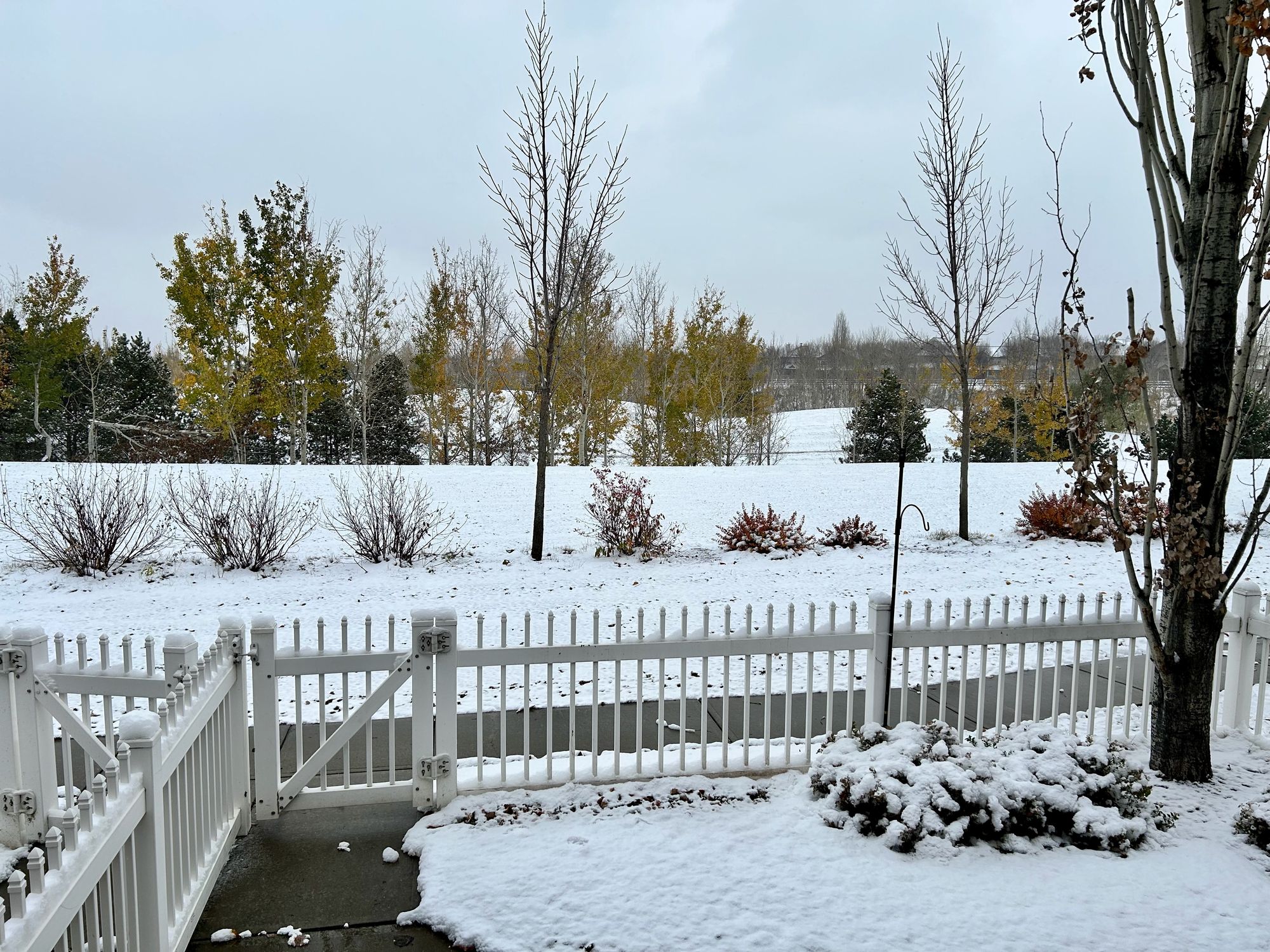Preparing For The Long Winter Ahead
The literal and figurative winters of our lives will eventually come. Here are a few things to help prepare for them.

Every Fall, I feel the anticipation of winter well before the snow falls. It looms larger in the back of my mind with each passing week, with an accompanying sense of grief over the loss of summer ease.
As the temperature drops and the days shorten, I turn the heat on in the house and start my wardrobe changeover. First, only the shorts and summer dresses get tucked away and replaced by light sweaters. The heavier pieces, mock necks and thick knits get added shortly after. I am both happy and sad to see them, cozy but a reminder of endlessly cold hands and feet.
When I change the sheets each Sunday, I evaluate if this will be the week I put the electric blanket back on the bed. I play chicken with my outdoor potted plants. I want to enjoy them for as long as possible, but not leave them out so long that I have to clean up the yard after the first snowfall (a mistake I've only made once and never again).
I bring up all our winter gear, freshly washed, and restock our Earl Grey, peppermint, and apple tea supplies— our go-to cold-weather comfort drinks after our usual morning coffees. Space heaters are strategically placed in the coldest areas of the house. I turn on the fairy lights around my writing desk each morning since the sun won’t be up until well after I’ve sat down to work. Slippers are donned, and a fuzzy blanket is laid out within easy reach, though it’s more often sacrificed to the cats for their daily kitten pile.
There is usually a stop-and-start of light snow in the final weeks of October, but we are ever hopeful that Halloween night will not be too bitter for the little ones to enjoy trick-or-treating. From my childhood experience, it’s the worst when you have to cover your costume with a snowsuit!
By the second week of November, it’s a sure thing; our corner of the world will be blanketed in white, and when daylight savings starts, I will write in the dark for several hours each morning.
It’s but a few weeks away from that now. The cold has settled in and won’t lift until the end of April.
Winter isn’t coming; it’s here.
Wintering
I recently read Katherine May’s Wintering: The Power of Rest and Retreat in Difficult Times, and it shifted my perspective on a season I typically dread. It’s a beautifully written part-memoir, part-reflection on winter in nature, literature and mythology.
May describes wintering as
“a season in the cold. It is a fallow period in life when you’re cut off from the world, feeling rejected, sidelined, blocked from progress, or cast into the role of an outsider… However it arrives, wintering is usually involuntary, lonely, and deeply painful. Yet it’s also inevitable.”
She gives examples of how plants and animals prepare to survive the winter and speaks to people from different parts of the world about their experiences and traditions that help them endure their winters. She describes the experience of figurative wintering during pain or sickness and the gifts of retreat and rest that come with them.
May’s exploration of the hidden depths of winter made me think about my own winters, literal and figurative, and the cyclical rather than linear nature of life.
Life in seasons
This time last year, in addition to the leaves changing and the threat of snow, I was just at the beginning of my first MS relapse. Throughout last winter, other life challenges also happened, like my brother being in intensive care for a month or managing the uproar of a home renovation. These were in addition to the regular ups and downs of work and life. It was a tough time, and I had many days when I felt sick, exhausted, and afraid.
But, of course, my season changed. I switched medications and started to feel better, my brother rallied and recovered, and our home was put back to rights. Spring came, and as always, the sun came out again. Things got easier.
As May wrote,
“Life meanders like a path through the woods. We have seasons when we flourish and seasons when the leaves fall from us, revealing our bare bones. Given time, they grow again.”
I grew again.

Preparing for the long winter ahead
When I finished May’s book, I thought about the winter ahead.
Winter is always hard for me, even without other life things happening. I have gone through this cycle many times. I know that as winter drags on, there is a slow but steady decline in the opportunities I create for connection and creativity.
These are things we all need to thrive.
The small barriers and hardships that come with the cold and darkness combine into endless reasons to hermit.
Now, don’t mistake me; I do love to hermit. It will always be my natural state, but sometimes I’m my own worst enemy. I must remember that I can protect my energy, recharge and rest as needed while also cultivating connection and creativity.
May said,
“We may never choose to winter, but we can choose how.”
I want to choose how I will winter, no matter what this particular winter brings. I want to prepare as best I can to make it easier.
I hope these help you prepare for your winter, too.
Make it easier to connect and create
1. Book things to look forward to
Managing the long, cold stretches can be easier when you have fun things on the horizon. Maybe it’s a concert or a weekend getaway, date night at your favourite local restaurant, pumpkin carving or building gingerbread houses, baking Christmas cookies, or going consignment shopping (those are all on my list!).
They don’t need to be fancy or expensive, just things to look forward to when you feel a little low. Think about a few things that you enjoy and get them booked in your calendar.
2. Choose ways to connect that fit into this season of your life
When I am tired and hermitting, the thought of planning a meal, cleaning our house, and hosting a dinner feels like a big commitment in our limited free time on the weekend. We decided that while we want to see and connect with our friends, we don’t need to make it a full weekend commitment. Instead, we invited our friends for weeknight drinks and snacks once a month. It’s low-effort and low-energy to prepare while still getting to connect.
Another way I enjoy connecting is by watching a show with my sister-in-law over WhatsApp, usually once a week for an hour. We are in our respective houses, but watch simultaneously and chat and talk smack about the characters. It’s a way for us to hang out without, you know, going out.😆
Other ways to connect with your friends when life is too full might be doing things together that you have to do anyway. Run errands together or walk the dog. Book a few hours to do a meal make-and-swap.
3. Take breaks from the noise and disconnect
Many of us spend an incredible amount of time in front of screens. I know I do. They are not necessarily bad and are often even good, but sometimes, they contribute to a feeling of noise and overwhelm. Think about ways to disconnect, even for just a few hours.
A few things you can do at home for introverts: painting, puzzles, adult colouring books, baking, board games, sudoku, crosswords, and reading. If you are more extroverted, try a class: pottery, yoga, cooking, dancing, music… they are endless, and many are inexpensive.
These all encourage creativity (and some even connection) and are not on a screen! Getting the creative juices flowing will also help inspire other areas of your life.

4. Collect your favourite things
What are the things that comfort you when you are feeling low?
It could be creating a backlog of books to read, so you don’t need to summon the mental energy to dig through reviews and scour the internet for ideas when there is little energy. It could be having all of the seasons of your favourite show queued up. Maybe it’s your favourite sweater, sweats, socks and blanket. Things that are warm, soft, and comforting. Perhaps it’s making your favourite soup now and freezing a few batches so you can pull it out on a night you want it.
Start collecting them now so they are ready when you need them.
5. Get outside and move
Fresh air, sunshine, and movement are ingredients for increased creativity, energy and motivation. This means collecting winter gear to make being outside manageable. It means planning outdoor walks with friends if the weather isn’t too bad. Maybe even just a few moments on your front step to breathe.
When everything in you says to stay inside and hibernate, try to push yourself to feel the sun on your face and move your body. You will feel better every time.
6. Rest and retreat
It may seem counterintuitive to include rest and retreat in this list, but often, it’s what’s required to recover from your winter. Be it the actual winter, sickness, pain, or hardship. Amongst all the busyness and demands, when your winter is at its deepest and darkest, let go of the pressure to do. Sometimes, the most “productive” thing you can do is “waste time.”
Where you can let go of the shoulds and allow yourself the privilege of rest and retreat.
An intentional winter
May writes,
“In our relentlessly busy contemporary world, we are forever trying to defer the onset of winter.”
But winter always comes, just as all the other seasons do. All you can do is prepare for them as best you can.
What will you do to be more intentional about the long winter ahead?
Overwhelmed? I can help. Book a free consultation to chat about how.
Share
Ashley Janssen

Productivity consultant, writer, speaker, serial entrepreneur, chaos calmer, introvert, cat-lady. Lover of books, fitness, old fashioned’s, basketball, and video games.
Follow me on
Twitter
or
LinkedIn.
Hire me for
1 on 1 productivity consulting
or
speaking.
Related articles

When Is It Enough?

What If Being Lazy Was a Good Thing?


Comments ()